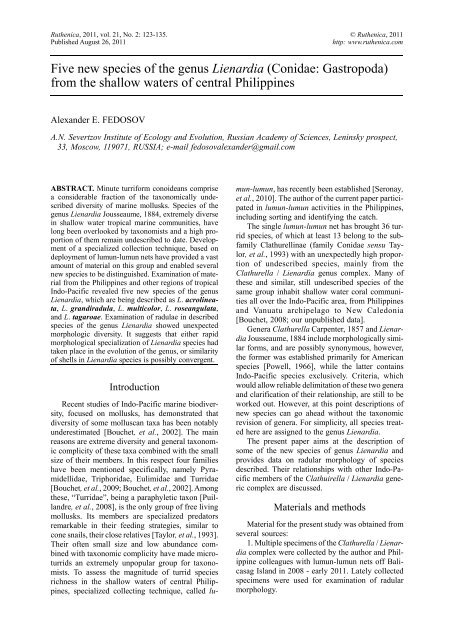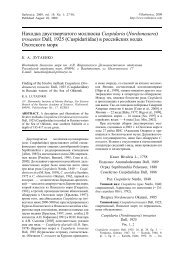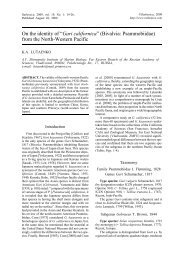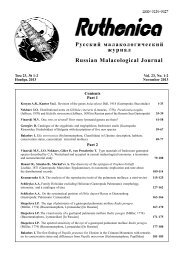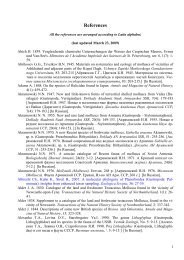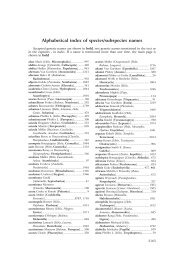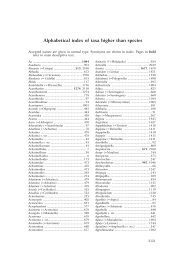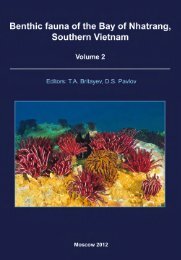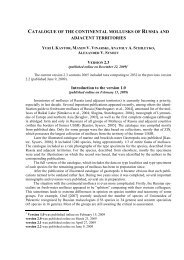Five new species of the genus Lienardia - "Ruthenica - Russian ...
Five new species of the genus Lienardia - "Ruthenica - Russian ...
Five new species of the genus Lienardia - "Ruthenica - Russian ...
Create successful ePaper yourself
Turn your PDF publications into a flip-book with our unique Google optimized e-Paper software.
Ru<strong>the</strong>nica, 2011, vol. 21, No. 2: 123-135.<br />
Published August 26, 2011<br />
ABSTRACT. Minute turriform conoideans comprise<br />
a considerable fraction <strong>of</strong> <strong>the</strong> taxonomically undescribed<br />
diversity <strong>of</strong> marine mollusks. Species <strong>of</strong> <strong>the</strong><br />
<strong>genus</strong> <strong>Lienardia</strong> Jousseaume, 1884, extremely diverse<br />
in shallow water tropical marine communities, have<br />
long been overlooked by taxonomists and a high proportion<br />
<strong>of</strong> <strong>the</strong>m remain undescribed to date. Development<br />
<strong>of</strong> a specialized collection technique, based on<br />
deployment <strong>of</strong> lumun-lumun nets have provided a vast<br />
amount <strong>of</strong> material on this group and enabled several<br />
<strong>new</strong> <strong>species</strong> to be distinguished. Examination <strong>of</strong> material<br />
from <strong>the</strong> Philippines and o<strong>the</strong>r regions <strong>of</strong> tropical<br />
Indo-Pacific revealed five <strong>new</strong> <strong>species</strong> <strong>of</strong> <strong>the</strong> <strong>genus</strong><br />
<strong>Lienardia</strong>, which are being described as L. acrolineata,<br />
L. grandiradula, L. multicolor, L. roseangulata,<br />
and L. tagaroae. Examination <strong>of</strong> radulae in described<br />
<strong>species</strong> <strong>of</strong> <strong>the</strong> <strong>genus</strong> <strong>Lienardia</strong> showed unexpected<br />
morphologic diversity. It suggests that ei<strong>the</strong>r rapid<br />
morphological specialization <strong>of</strong> <strong>Lienardia</strong> <strong>species</strong> had<br />
taken place in <strong>the</strong> evolution <strong>of</strong> <strong>the</strong> <strong>genus</strong>, or similarity<br />
<strong>of</strong> shells in <strong>Lienardia</strong> <strong>species</strong> is possibly convergent.<br />
Introduction<br />
Recent studies <strong>of</strong> Indo-Pacific marine biodiversity,<br />
focused on mollusks, has demonstrated that<br />
diversity <strong>of</strong> some molluscan taxa has been notably<br />
underestimated [Bouchet, et al., 2002]. The main<br />
reasons are extreme diversity and general taxonomic<br />
complicity <strong>of</strong> <strong>the</strong>se taxa combined with <strong>the</strong> small<br />
size <strong>of</strong> <strong>the</strong>ir members. In this respect four families<br />
have been mentioned specifically, namely Pyramidellidae,<br />
Triphoridae, Eulimidae and Turridae<br />
[Bouchet, et al., 2009; Bouchet, et al., 2002]. Among<br />
<strong>the</strong>se, “Turridae”, being a paraphyletic taxon [Puillandre,<br />
et al., 2008], is <strong>the</strong> only group <strong>of</strong> free living<br />
mollusks. Its members are specialized predators<br />
remarkable in <strong>the</strong>ir feeding strategies, similar to<br />
cone snails, <strong>the</strong>ir close relatives [Taylor, et al., 1993].<br />
Their <strong>of</strong>ten small size and low abundance combined<br />
with taxonomic complicity have made microturrids<br />
an extremely unpopular group for taxonomists.<br />
To assess <strong>the</strong> magnitude <strong>of</strong> turrid <strong>species</strong><br />
richness in <strong>the</strong> shallow waters <strong>of</strong> central Philippines,<br />
specialized collecting technique, called lu-<br />
mun-lumun, has recently been established [Seronay,<br />
et al., 2010]. The author <strong>of</strong> <strong>the</strong> current paper participated<br />
in lumun-lumun activities in <strong>the</strong> Philippines,<br />
including sorting and identifying <strong>the</strong> catch.<br />
The single lumun-lumun net has brought 36 turrid<br />
<strong>species</strong>, <strong>of</strong> which at least 13 belong to <strong>the</strong> subfamily<br />
Clathurellinae (family Conidae sensu Taylor,<br />
et al., 1993) with an unexpectedly high proportion<br />
<strong>of</strong> undescribed <strong>species</strong>, mainly from <strong>the</strong><br />
Clathurella / <strong>Lienardia</strong> <strong>genus</strong> complex. Many <strong>of</strong><br />
<strong>the</strong>se and similar, still undescribed <strong>species</strong> <strong>of</strong> <strong>the</strong><br />
same group inhabit shallow water coral communities<br />
all over <strong>the</strong> Indo-Pacific area, from Philippines<br />
and Vanuatu archipelago to New Caledonia<br />
[Bouchet, 2008; our unpublished data].<br />
Genera Clathurella Carpenter, 1857 and <strong>Lienardia</strong><br />
Jousseaume, 1884 include morphologically similar<br />
forms, and are possibly synonymous, however,<br />
<strong>the</strong> former was established primarily for American<br />
<strong>species</strong> [Powell, 1966], while <strong>the</strong> latter contains<br />
Indo-Pacific <strong>species</strong> exclusively. Criteria, which<br />
would allow reliable delimitation <strong>of</strong> <strong>the</strong>se two genera<br />
and clarification <strong>of</strong> <strong>the</strong>ir relationship, are still to be<br />
worked out. However, at this point descriptions <strong>of</strong><br />
<strong>new</strong> <strong>species</strong> can go ahead without <strong>the</strong> taxonomic<br />
revision <strong>of</strong> genera. For simplicity, all <strong>species</strong> treated<br />
here are assigned to <strong>the</strong> <strong>genus</strong> <strong>Lienardia</strong>.<br />
The present paper aims at <strong>the</strong> description <strong>of</strong><br />
some <strong>of</strong> <strong>the</strong> <strong>new</strong> <strong>species</strong> <strong>of</strong> <strong>genus</strong> <strong>Lienardia</strong> and<br />
provides data on radular morphology <strong>of</strong> <strong>species</strong><br />
described. Their relationships with o<strong>the</strong>r Indo-Pacific<br />
members <strong>of</strong> <strong>the</strong> Clathuirella / <strong>Lienardia</strong> generic<br />
complex are discussed.<br />
Materials and methods<br />
© Ru<strong>the</strong>nica, 2011<br />
http: www.ru<strong>the</strong>nica.com<br />
<strong>Five</strong> <strong>new</strong> <strong>species</strong> <strong>of</strong> <strong>the</strong> <strong>genus</strong> <strong>Lienardia</strong> (Conidae: Gastropoda)<br />
from <strong>the</strong> shallow waters <strong>of</strong> central Philippines<br />
Alexander E. FEDOSOV<br />
A.N. Severtzov Institute <strong>of</strong> Ecology and Evolution, <strong>Russian</strong> Academy <strong>of</strong> Sciences, Leninsky prospect,<br />
33, Moscow, 119071, RUSSIA; e-mail fedosovalexander@gmail.com<br />
Material for <strong>the</strong> present study was obtained from<br />
several sources:<br />
1. Multiple specimens <strong>of</strong> <strong>the</strong> Clathurella / <strong>Lienardia</strong><br />
complex were collected by <strong>the</strong> author and Philippine<br />
colleagues with lumun-lumun nets <strong>of</strong>f Balicasag<br />
Island in 2008 - early 2011. Lately collected<br />
specimens were used for examination <strong>of</strong> radular<br />
morphology.
124 Fedosov A.E.<br />
2. Some material, used in <strong>the</strong> present study was<br />
collected during different cruises and shore based<br />
expeditions in central Indo-Pacific and Pacific regions,<br />
undertaken by Muséum National d’Histoire<br />
Naturelle, Paris, France (MNHN).<br />
3. Additional dry material, originated from different<br />
localities in Philippine archipelago was kindly<br />
donated by Mr. Guido Poppe (Conchology Inc.,<br />
Lapu-Lapu City, Cebu, Philippines).<br />
Shells <strong>of</strong> specimens for radulae examinations<br />
were photographed and bored with a micro-drill;<br />
<strong>the</strong> s<strong>of</strong>t bodies were extracted and dissected. The<br />
radular sacs were dissected out and treated with 5%<br />
solution <strong>of</strong> potassium hypochlorite until <strong>the</strong> s<strong>of</strong>t<br />
tissues were completely dissolved. In minute specimens<br />
entire buccal complexes were dissolved. Radulae<br />
<strong>the</strong>n were cleaned in several shifts <strong>of</strong> distilled<br />
water, air-dried and mounted for SEM analysis.<br />
Abbreviations <strong>of</strong> museums and depositories:<br />
MNHN – Muséum National d’Histoire Naturelle,<br />
Paris, France<br />
PBRC – Philippine Biodiversity Resource Center,<br />
Metro Manila, Philippines<br />
ANSP – Academy <strong>of</strong> Natural Science, Philadelphia,<br />
USA<br />
Conchology Inc. – Private collection <strong>of</strong> Conchology<br />
Inc., Lapu-Lapu City, Cebu, Philippines<br />
Results<br />
Taxonomy<br />
Family Conidae Fleming, 1822<br />
Subfamily Clathurellinae H. et A. Adams, 1858<br />
Genus <strong>Lienardia</strong> Jousseaume, 1884<br />
Type <strong>species</strong>: Clavatula rubida Hinds, 1843, by<br />
original designation.<br />
<strong>Lienardia</strong> acrolineata sp. nov.<br />
(Fig. 1, 6 C-E)<br />
Holotype: 6.4 x 2.5 mm, 50–100 m, lumunlumun<br />
net, Balicasag Is, Bohol, Philippines (PBRC)<br />
(Fig. 1 A-C).<br />
Paratypes: Paratype 1, 6.1 x 2.6 mm, Maribojok<br />
Is, Bohol, Philippines, 10–15 m, (MNHN 24441)<br />
(Fig. 1 D, E); Paratype 2, 5.9 x 2.4 mm, lumunlumun<br />
net, Siquijor Is, Philippines, 80 m, (ANSP<br />
426056) (Fig. 1 F, G); Paratype 3, 5.8 x 2.3 mm,<br />
Maribojok Is, Bohol, Philippines, 10–15 m, (Conchology<br />
Inc.).<br />
O<strong>the</strong>r material examined: SL 5.4 mm, Loyalty Islands,<br />
Lifou, Atelier LIFOU, Stn. 1453: 20º54.6’S, 167º02.1’E, 21-<br />
30 m; SL 5.2 mm, MNHN; Stn. 1424: 20º54.9’S, 167º03.0’E,<br />
4 m, MNHN; SL 4.3 mm, SL 4 mm, Stn. 1429: 20º47.5’S,<br />
167º07.1’E, 8-18 m, MNHN; 5.5 x 2.2 mm, 50–100 m, lumunlumun<br />
net, Balicasag Is, Bohol, Philippines; 5.1 x 2.2 mm,<br />
80 m, lumun-lumun net, Siquijor Is, Philippines, juvenile;<br />
4.4 x 2 mm, 40–50 m, lumun-lumun net, Balicasag Is, Bohol,<br />
Philippines; 4.6 x 2 mm, 40–50 m, lumun-lumun net,<br />
Balicasag Is, Bohol, Philippines.<br />
Type locality: Philippines, Balicasag Is.<br />
Description. Shell small, elongate fusiform (proportion<br />
<strong>of</strong> shell width to its length 0.4-0.42, body<br />
whorl to shell length – 0.57-0.59), with high spire.<br />
Teleoconch <strong>of</strong> 5 evenly convex whorls. Suture indistinct.<br />
Axial sculpture <strong>of</strong> strong rounded ribs (10-<br />
12 per whorl). Spiral sculpture <strong>of</strong> two fine threads<br />
in subsutural region followed by four strong spiral<br />
cords. Spiral cords wavy, strongest when intersect<br />
axial ribs, <strong>the</strong>re <strong>the</strong>y form spirally elongate nodules;<br />
body whorl with five such spiral cords. Four<br />
spiral cords, interrupted between axial ribs on shell<br />
base, followed by three spiral threads on siphonal<br />
canal. Fasciole moderately pronounced. Shell surface<br />
mat, sculptured by dense micro-tubercles.<br />
Siphonal canal distinct, strongly notched. Aperture<br />
narrow, outer lip convex, inner lip straight.<br />
Outer lip moderately thickened and slightly inwardly<br />
curved, with five tubercles, two upper strongest.<br />
Varix well developed behind aperture outer lip.<br />
Inner lip with four tubercles <strong>of</strong> subequal size. Anal<br />
sinus deep, tear-shaped, separated from aperture by<br />
strong “subsutural tubercle”.<br />
Background color light olive in fresh specimens<br />
or yellowish in faded ones. Pale brown spots on<br />
subsutural area in interspaces between axial ribs.<br />
Smaller spots on spiral elements <strong>of</strong> shell base. Interspaces<br />
between spiral cords marked with fine<br />
brown lines. Fasciole with dark band, spreading to<br />
inner lip.<br />
Protoconch orthoconoid, <strong>of</strong> four whorls. Protoconch<br />
I dark brown to black, with evenly convex<br />
whorls, bearing one spiral keel. Protoconch II lightyellowish,<br />
<strong>of</strong> strongly angular whorls, bearing two<br />
gemmate spiral keels, one marking whorl periphery,<br />
second situated right above <strong>the</strong> suture.<br />
[Диагноз. Раковина небольшая, удлинённо-веретеновидная<br />
(отношение высоты раковины к её ширине 0,4-<br />
0,42, отношение высоты последнего оборота к высоте<br />
раковины – 0,57-0,59), с высоким завитком. Телеоконх<br />
образован пятью равномерно закруглёнными оборотами.<br />
Шов плохо заметен. Осевая скульптура представлена<br />
мощными скруглёнными складками (10-12 на каждом<br />
обороте). Спиральная скульптура из двух тонких линий<br />
в пришовной области оборота и четырёх мощных широких<br />
рёбер. Спиральные рёбра волнистые, лучше развиты<br />
на пересечениях с осевыми складками, где они формируют<br />
спирально вытянутые бугорки. Последний оборот<br />
с пятью спиральными рёбрами; основание раковины<br />
с четырьмя спиральными рёбрами прерывающимися в<br />
интервалах между осевыми складками.<br />
Сифональный канал хорошо выражен, с заметной<br />
вырезкой. Фасциола не развита. Устье узкое, внешняя<br />
губа равномерно закруглена, внутренняя губа прямая.<br />
Внешняя губа утолщена и слегка загнута внутрь, с пятью<br />
бугорками на внутренней поверхности. Варикс хо-
<strong>Five</strong> <strong>new</strong> <strong>species</strong> <strong>of</strong> <strong>Lienardia</strong> (Conidae) from Philippines<br />
FIG. 1. <strong>Lienardia</strong> acrolineata sp.nov.; A-C – Holotype, PBRC (details in text); D, E – Paratype 1, MNHN 24441; F, G –<br />
Paratype 2, ANSP 426056; H – Loyalty Islands, expedition Atelier LIFOU, Stn. 1453: 20º54.6’S, 167º02.1’E, 21-30m, 5.4<br />
mm, voucher shell for radular study<br />
РИС. 1. <strong>Lienardia</strong> acrolineata sp.nov.; A-C – Голотип, PBRC (см. Текст); D, E – Паратип 1, MNHN 24441; F, G – Паратип<br />
2, ANSP 426056; H – острова Лойалти, экспедиция Atelier LIFOU, Ст. 1453: 20º54.6’S, 167º02.1’E, 21-30м, 5,4 мм,<br />
экземпляр, использованный для исследования радулы.<br />
рошо развит, позади внешней губы. Внутренняя губа с<br />
четырьмя бугорками. Анальный синус глубокий, воронковидный.<br />
Раковина светло-оливковая с отчётливыми коричневыми<br />
пятнами на пришовных частях оборотов и сифонгальном<br />
канале и тонкими коричневыми линиями в промежутках<br />
между спиральными рёбрами. Сифональный<br />
канал и варикс частично окрашены коричневым. Поверхность<br />
раковины матовая, скульптурирована многочисленными<br />
микроскопическими бугорками.<br />
Протоконх ортоконоидный из 4х оборотов. Протоконх<br />
125<br />
I тёмно-коричневый до чёрного с равномерно закруглёнными<br />
оборотами и одним спиральным килем. Обротоконх<br />
II жёлтый с угловатыми оборотами, несущими 2<br />
спиральных киля, на периферии оборота и над швом.]<br />
Remarks: <strong>Lienardia</strong> acrolineata sp. nov. is similar<br />
to <strong>Lienardia</strong> mighelsi Iredale et Tomlin, 1917,<br />
from which it could be differentiated due to its<br />
characteristic color pattern with fine brown lines<br />
and contrasting dots, marking suture.
126 Fedosov A.E.<br />
Radula. Short, consists <strong>of</strong> ca. 15 pairs <strong>of</strong> hypodermic<br />
marginal teeth. Single tooth (Fig. 6 C, D) is<br />
250-260 µm in length, with two opposite well pronounced<br />
terminal barbs, <strong>of</strong> which one larger and<br />
notably shifted down. Canal pore opens terminally,<br />
right sideway from lower barb (Fig. 6 E).<br />
Etymology. akron- (Greek) – peak, summit; linea-<br />
(Latin) – line. The <strong>species</strong> name refers to multiple<br />
brown spiral lines, characteristic for this <strong>species</strong>.<br />
Distribution: Philippines to Vanuatu and New<br />
Caledonia, shallow waters to 100 m depth.<br />
<strong>Lienardia</strong> grandiradula sp. nov.<br />
(Fig. 2, 6 F, G)<br />
Holotype: 10.0 x 4.0 mm, Philippines, Panglao<br />
Is., 9°37.6’N, 123°47.3’E, 20 m, MNHN 24439<br />
(Fig. 2 A, B).<br />
Paratypes: Paratype 1: 10.4 x 4.2 mm, lumunlumun<br />
net, Philippines (PBRC) (Fig. 2 C, D);<br />
Paratype 2, 9.4 x 3.8 mm, Balicasag Is, Philippines<br />
(PBRC) (Fig. 2 E, F); Paratype 3, 9.0 x 3.9 mm,<br />
Balicasag Is, Philippines (ANSP 426057) (Fig. 2, G,<br />
H); Paratype 4, 8.2 x 3.3 mm, Balicasag Is, Philippines<br />
(ANSP 426057); Paratype 5, 10.2 x 4.3 mm,<br />
Is, Philippines (Conchology Inc).<br />
Type locality: Philippines, Panglao Island.<br />
Description. Shell fusiform (proportion <strong>of</strong> shell<br />
width to length 0.41-0.43, body whorl to shell length<br />
– 0.61). Teleoconch <strong>of</strong> 5.5–6 evenly convex whorls<br />
without distinct shoulder. Suture indistinct, subsutural<br />
ramp weakly pronounced. Shells sculpture <strong>of</strong><br />
regular rounded axial ribs (13 on body whorl), intersected<br />
with fine widely spaced spiral cords. Subsutural<br />
ramp with two fine spiral threads, succeeded<br />
with three-four spiral cords on earlier spire whorls<br />
and five on penultimate one. Interspaces between<br />
3 rd , 4 th and 5 th spiral cords with minute vanishing<br />
riblets. Body whorl with eight spiral cords.<br />
Siphonal canal relatively long, slightly recurved<br />
at its tip, clearly notched. Fasciole absent. Sculpture<br />
<strong>of</strong> siphonal canal <strong>of</strong> nine spiral cords, separated<br />
from spiral elements <strong>of</strong> body whorl base by wide<br />
interspace. Last spiral cord <strong>of</strong> body whorl and three<br />
first cords <strong>of</strong> siphonal canal formed by spirally<br />
elongate nodules.<br />
Aperture narrow, outer lip thickened with 4-6<br />
denticles <strong>of</strong> equal or subequal size, opposed by four<br />
denticles on straight inner lip. Varix well pronounced<br />
positioned behind outer lip. Anal sinus relatively<br />
wide, funnel-shaped.<br />
Background coloration light-orange to light-olive<br />
with darker subsutural ramps. Body whorl with<br />
two ra<strong>the</strong>r indistinct darker bands, one on periphery<br />
and ano<strong>the</strong>r, marking shell base.<br />
Protoconch orthoconoid, <strong>of</strong> 2.5 convex whorls,<br />
brown. Later whorls with two distinct keels – one on<br />
whorl periphery, ano<strong>the</strong>r immediately above suture.<br />
[Диагноз. Раковина веретеновидная (отношение высоты<br />
раковины к её ширине 0,41-0,43, отношение высоты<br />
последнего оборота к высоте раковины – 0,61). Телеоконх<br />
из 5,5–6-ти равномерно выпуклых оборотов. Шов<br />
плохо заметен. Скульптура из регулярных осевых складок<br />
(13 на последнем обороте), пересекаемых тонкими,<br />
широко расставленными спиральными рёбрами. Пришовные<br />
области оборотов с двумя тонкими линиями; ранние<br />
обороты завитка с тремя-четырьмя; предпоследний оборот<br />
с пятью спиральными рёбрами. Интервалы между 3м,<br />
4-м и 5-м спиральными ребрами с мелкими промежуточными<br />
рёбрышками. Последний оборот с восьмью спиральными<br />
рёбрами.<br />
Сифональный канал относительно длинный со слегка<br />
отогнутым кончиком. Фасциола не выражена. Сифональный<br />
канал с девятью спиральными косыми рёбрами,<br />
отделёнными от спиральных элементов последнего<br />
оборота широким интервалом.<br />
Устье узкое, внешняя губа утолщена с 4-6 зубчиками<br />
равного или почти равного размера на внутренней поверхности,<br />
внешняя губа прямая с четырьмя зубчиками.<br />
Варикс хорошо выражен позади внешней губы. Анальный<br />
канал глубокий и широкий, воронковидный.<br />
Раковина светло-оранжевая до оливковой, с более<br />
тёмными пришовными частями оборотов. Последний<br />
оборот с двумя спиральными тёмными полосами – на<br />
периферии оборота и в основании раковины.<br />
Протоконх ортоконоидный, из 2,5 оборотов, коричневый.<br />
Поздние обороты протоконха с двумя ясными<br />
килями, на периферии раковины и прямо над швом.]<br />
Remarks: <strong>Lienardia</strong> grandiradula sp. nov. conchologically<br />
close to <strong>Lienardia</strong> mighelsi Iredale et<br />
Tomlin, 1917 and has similar color pattern. However,<br />
<strong>the</strong> <strong>species</strong> differs in having 1) larger and wider<br />
shell with ra<strong>the</strong>r biconical outline; 2) a characteristic<br />
spiral dark band, marking periphery <strong>of</strong> <strong>the</strong> body<br />
whorl.<br />
Radula. Radula remarkably large, <strong>of</strong> few pairs<br />
<strong>of</strong> hypodermic marginals. Each marginal tooth slightly<br />
curved near its base and attains length <strong>of</strong> ca. 550<br />
µm (Fig. 6 F, G). Teeth tips with no barbs, but bear<br />
two opposite weakly developed blades.<br />
Etymology. The <strong>species</strong> name refers to unusually<br />
large radular teeth found in this <strong>species</strong>.<br />
Distribution. Philippines, Cebu-Bohol area,<br />
shallow waters.<br />
<strong>Lienardia</strong> multicolor sp. nov.<br />
(Fig. 3)<br />
Holotype. 6.6 x 2.9 mm, lumun-lumun net, Balicasag<br />
Is, Bohol, Philippines (PBRC) (Fig. 3 A-C).<br />
Paratypes. Paratype 1, 6.4 x 2.7 mm, Siquijor<br />
Is, Philippines, lumun-lumun net, 80 m (MNHN<br />
24442) (Fig. 3 D, E); Paratype 2, 5.1 x 2.4 mm,<br />
Siquijor Is, Philippines, lumun-lumun net, 80 m<br />
(ANSP 426059) (Fig. 3 F, G).<br />
Type locality: Philippines, Siquijor Island.<br />
Description. Shell small, fusiform (proportion<br />
<strong>of</strong> shell width to its length 0.42-0.44, body whorl to<br />
shell length – 0.6), <strong>of</strong> 5.5 strongly convex teleo-
<strong>Five</strong> <strong>new</strong> <strong>species</strong> <strong>of</strong> <strong>Lienardia</strong> (Conidae) from Philippines<br />
FIG. 2. <strong>Lienardia</strong> grandiradula sp. nov.; A, B – Holotype, MNHN 24439 (details in text); C, D – Paratype 1, PBRC; E, F –<br />
Paratype 2, PBRC; G, H – Paratype 3, ANSP 426057; I – Balicasag Is, Bohol, Philippines, lumun-lumun net, 35-50 m, 9.3<br />
mm, voucher shell for radular study<br />
РИС. 2. <strong>Lienardia</strong> grandiradula sp. nov.; A, B – Голотип, MNHN 24439 (см. текст); C, D – Паратип 1, PBRC; E, F –<br />
Паратип 2, PBRC; G, H – Паратип 3, ANSP 426057; I – о-в Баликасаг, Бохол, Филиппины, лумун-лумун, 35-50 м, 9,3<br />
мм, экземпляр, использованный для исследования радулы.<br />
conch whorls. Suture indistinct; subsutural region<br />
slightly concave, with three weak wavy spiral<br />
threads. Axial sculpture <strong>of</strong> strong prominent broadly<br />
rounded ribs (10 per whorl). Axial ribs intersected<br />
with spiral cords that form glossy spirally elongated<br />
nodules. Spire whorls with three to five such<br />
spiral cords, <strong>of</strong> which 2 nd , 3 rd and 4 th , closest to<br />
whorl periphery strongest. Base <strong>of</strong> body whorl with<br />
4 spiral cords, similar to those on whorl periphery,<br />
127<br />
succeeded by 6 spiral cords on siphonal canal. Shell<br />
surface mat, with fine micro-sculpture <strong>of</strong> dense<br />
micro-tubercles.<br />
Siphonal canal well defined, straight, shallowly<br />
notched; fasciole moderately developed. Aperture<br />
elongate, narrow. Outer lip slightly thickened, with<br />
4 subequal denticles inside. Varix well developed,<br />
situated behind outer lip. Inner aperture lip with<br />
three indistinct denticles. Anal sinus deep, tear-
128 Fedosov A.E.<br />
FIG. 3. <strong>Lienardia</strong> multicolor sp. nov.; A-C – Holotype, PBRC (details in text); D, E – Paratype 1, MNHN 24442; F, G –<br />
Paratype 2, ANSP 426059.<br />
РИС. 3. <strong>Lienardia</strong> multicolor sp. nov.; A-C – Голотип, PBRC (см. Текст); D, E – Паратип 1, MNHN 24442; F, G – Паратип<br />
2, ANSP 426059.<br />
shaped, restricted by prominent subsutural tubercle.<br />
Background coloration tan with subsutural regions<br />
darkened, spiral ribs yellow. Shell base marked<br />
with white spiral band, protoconch and siphonal<br />
canal pink.<br />
Protoconch: bluntly orthoconoid, <strong>of</strong> 2.5 whorls,<br />
pink, glossy, with two distinct keels on later whorls.<br />
[Диагноз. Раковина мелкая, веретеновидная (отношение<br />
высоты раковины к её ширине 0,42-0,44, отношение<br />
высоты последнего оборота к высоте раковины – 0,6).<br />
Телеоконх из 5,5 сильно выпуклых оборотов. Шов плохо<br />
заметен. Пришовная область слегка вогнутая с тремя<br />
тонкими волнистыми спиральными линиями. Осевая<br />
скульптура из мощных широких складок (10 на последнем<br />
обороте). Осевые складки пересечены спиральными<br />
рёбрами, образующими в месте пересечения гладкие
спирально-вытянутые бугорки. Обороты завитка с 3-5<br />
спиральными рёбрами такого же строения, наиболее мощные<br />
находятся на периферии оборота . Основание последнего<br />
оборота с 4-мя спиральными рёбрами.<br />
Сифональный канал хорошо выражен, прямой, с неглубокой<br />
вырезкой, скульптурирован 6 спиральными рёбрами.<br />
Фасциола развита умеренно. Устье удлинённое,<br />
узкое. Внешняя губа незначительно утолщена с 4-мя бугорками<br />
на внутренней стороне; варикс хорошо выражен,<br />
позади внешней губы. Внутренняя губа устья с тремя<br />
небольшими бугорками. Анальный синус глубокий, воронковидный.<br />
Раковина светло коричневая с более тёмными пришовными<br />
частями оборотов и жёлтыми спиральными<br />
рёбрами. Основание раковины со спиральной белой полосой,<br />
протоконх и, частично, сифональный канал розовые.<br />
Поверхность раковины матовая, густо скульптурирована<br />
микро-бугорками.<br />
Протоконх широко ортоконоидный, из 2.5 оборотов<br />
с двумя отчётливыми килями на поздних оборотах.]<br />
Remarks: <strong>Lienardia</strong> multicolor sp. nov. superficially<br />
resembles L. crassicostata (Pease, 1860),<br />
but could be easily differentiated due to its characteristic<br />
coloration.<br />
Radula. No data.<br />
Etymology. The name <strong>of</strong> this <strong>species</strong> was inspired<br />
by its characteristic color pattern.<br />
Distribution. Central Philippines, depths 50-<br />
150 m.<br />
<strong>Lienardia</strong> roseangulata sp. nov.<br />
(Fig. 4, 6 H, I)<br />
Holotype: 4.6 x 1.9 mm, Vanuatu, SANTO 2006,<br />
Stn. EP36, 15°33.2’S, 167°12.5’E, 20-60 m, MNHN<br />
24440, IM-2009-18091 (Fig. 4 A, B)<br />
Paratypes: Paratype 1, 5.7 x 2.45 mm, Balicasag<br />
Is, Bohol, Philippines, lumun-lumun net, 35-<br />
50 m, PBRC (Fig. 4 C, D); Paratype 2, 5.6 x 2.3<br />
mm, same locality, Conchology Inc. (Fig. 4 E, F).<br />
O<strong>the</strong>r material examined: 5.8 x 2.65 mm, Loyalty<br />
Islands, Lifou, Atelier LIFOU, Stn. 1461, 20°54.0’S,<br />
167°02.1’E, 100-200 m, MNHN.<br />
Type locality: Philippines, Balicasag Island.<br />
Description. Shell small, fusiform (proportion<br />
<strong>of</strong> shell width to length varies from 0.42 in smaller<br />
specimens to 0.46 in larger ones, due to notably<br />
recurved upper outer lip). Teleoconch <strong>of</strong> 5–5.5<br />
strongly convex to angulated shouldered whorls.<br />
Suture indistinct, subsutural ramp sloping, with fine<br />
wavy threads. Axial sculpture <strong>of</strong> strongly elevated<br />
ribs (10 on body whorl), latest 4-5 ribs clearly<br />
angulated with <strong>the</strong> whorl periphery slightly shifted<br />
down. Axial ribs intersected by fine spiral cords,<br />
slightly widened in intersections. Spire whorls with<br />
4-5 spiral cords, <strong>of</strong> which second marks shoulder.<br />
Body whorl with 8 spiral cords, succeeded with 6<br />
spiral to obliquely-spiral cords on siphonal canal.<br />
Siphonal canal relatively long, straight, slightly<br />
notched, fasciole absent. Aperture narrow, its outer<br />
<strong>Five</strong> <strong>new</strong> <strong>species</strong> <strong>of</strong> <strong>Lienardia</strong> (Conidae) from Philippines<br />
129<br />
lip strongly thickened and inwardly curved. Inner<br />
margin <strong>of</strong> outer lip with 5 denticles. Uppermost<br />
margin <strong>of</strong> outer lip angulated and notably recurved<br />
due to well developed, wide anal sinus. Inner aperture<br />
lip almost straight with three closely spaced<br />
little denticles in its medial part.<br />
Shell pink with periphery <strong>of</strong> body whorl bearing<br />
spiral light band, distinct in fresh shells.<br />
Protoconch pink to brownish, <strong>of</strong> 2.5 convex<br />
whorls. Later whorls with two strong keels, <strong>of</strong> which<br />
upper marks whorl periphery, while lower runs immediately<br />
above suture.<br />
[Диагноз. Раковина мелкая, веретеновидная (отношение<br />
высоты раковины к её ширине от 0,42 у более мелких<br />
экземпляров до 0,46 у более крупных за счёт значительно<br />
отогнутого верхнего края внешней губы). Телеоконх<br />
из 5-5,5 сильно выпуклых до угловатых оборотов<br />
иногда с выраженным плечом. Шов плохо заметен, пришовная<br />
область крутая с тонкими спиральными линиями.<br />
Осевая скульптура из мощных складок (10 на последнем<br />
обороте), последние 4-5 складок отчётливо угловатые.<br />
Осевые складки пересечены тонкими спиральными<br />
рёбрами, слегка утолщенными в местах пересечений.<br />
Обороты завитка с 4-5 спиральными рёбрами. Последний<br />
оборот с 8 спиральными рёбрами.<br />
Сифональный канал относительно длинный, прямой,<br />
с небольшой вырезкой, скульптурирован 6-ю осевыми до<br />
косых рёбрами. Фасциола не выражена. Устье узкое, внешняя<br />
губа устья сильно утолщена и загнута внутрь, несёт<br />
5 зубчиков, обращённых к устью. Верхний край внешней<br />
губы значительно отстоит от основания последнего<br />
оборота за счёт широкого и глубокого анального синуса.<br />
Внешняя губа устья почти прямая с тремя мелкими зубчиками<br />
в средней части.<br />
Раковина розовая, периферия последнего оборота со<br />
спиральной белой полосой.<br />
Протоконх розовый до коричневатого из 2,5 выпуклых<br />
оборотов. Поздние обороты протоконха с двумя отчётливыми<br />
килями, на периферии раковины и прямо над швом.]<br />
Remarks: <strong>Lienardia</strong> roseangulata sp. nov. similar<br />
to Glyphostoma lamproideum Hervier, 1896, but<br />
<strong>the</strong> latter <strong>species</strong> is not pink and has more numerous<br />
columella pleats. <strong>Lienardia</strong> fallaciosa Hedley, 1922,<br />
is also close in shape to <strong>the</strong> <strong>species</strong> described, but<br />
lacks <strong>the</strong> pink colour. <strong>Lienardia</strong> roseangulata sp.<br />
nov. also resembles L. roseotincta (Montrouzier,<br />
1871), but differs in having a proportionally shorter<br />
siphonal canal and higher spire. Relatively higher<br />
spire and characteristic notably angulated axial ribs<br />
<strong>of</strong> body whorl distinguish this <strong>species</strong> from a complex<br />
<strong>of</strong> similarly colored, still undescribed <strong>Lienardia</strong><br />
<strong>species</strong>, co-occurring with <strong>Lienardia</strong> roseangulata<br />
in Central Indo-Pacific.<br />
Radula. Radula small, <strong>of</strong> 15-20 pairs <strong>of</strong> hypodermic<br />
marginal teeth, length 130-140 µm, some<br />
teeth slightly bent near tips (Fig. 6 H, I). Tooth tip<br />
with two well developed opposite barbs <strong>of</strong> equal<br />
size. Pore <strong>of</strong> canal opens subterminally right below<br />
barb, with minute projection below <strong>the</strong> lower margin<br />
<strong>of</strong> <strong>the</strong> pore.
130 Fedosov A.E.<br />
FIG. 4. <strong>Lienardia</strong> roseangulata sp. nov.; A, B – Holotype, MNHN 24440 (details in text); C, D – Paratype 1, PBRC; E, F –<br />
Paratype 2, Conchology Inc.<br />
РИС. 4. <strong>Lienardia</strong> roseangulata sp. nov.; A, B – Голотип, MNHN 24440 (см. Текст); C, D – Паратип 1, PBRC; E, F –<br />
Паратип 2, Conchology Inc.<br />
Etymology. The name <strong>of</strong> this <strong>species</strong> refers to<br />
<strong>the</strong> general coloration <strong>of</strong> <strong>the</strong> shell, which is colored<br />
pink and to <strong>the</strong> characteristic angulated axial ribs,<br />
marking <strong>the</strong> shell base.<br />
Distribution. Philippines, Vanuatu and New<br />
Caledonia, 20-200 m.<br />
<strong>Lienardia</strong> tagaroae sp. nov.<br />
(Fig. 5, 6 J, K)<br />
Holotype: 5.9 x 2.5 mm, Philippines, Balicasag<br />
Is., 9°30.9N, 123°41.2’E, 90-110 m (MNHN 24438)<br />
(Fig. 5 A, B)<br />
Paratypes: Paratype 1, 8.3 x 3.5 mm, lumunlumun<br />
net, <strong>of</strong>f Punta Engano, Mactan Is, Philippines,<br />
50-150 m, (PBRC) (Fig. 5 C, D); Paratype 2,<br />
6.0 x 2.6 mm, Balicasag Is, Bohol, Philippines<br />
(PBRC) (Fig. 5 E, F); Paratype 3, 5.3 x 2.3 mm,<br />
Balicasag Is, Bohol, Philippines (ANSP 426060)<br />
(Fig. 5 G, H); Paratype 4, 6.5 x 2.8 mm, Balicasag<br />
Is, Bohol, Philippines (ANSP 426060) Paratype 5,<br />
6.7 mm, Balicasag Is, Bohol, Philippines, lumunlumun<br />
net, 35-50 m (Conchology Inc.).<br />
Type locality: Philippines, Balicasag Island.<br />
Description. Shell small, fusiform (proportion<br />
<strong>of</strong> shell width to its length 0.42-0.43, body whorl
<strong>Five</strong> <strong>new</strong> <strong>species</strong> <strong>of</strong> <strong>Lienardia</strong> (Conidae) from Philippines<br />
FIG. 5. <strong>Lienardia</strong> tagaroae sp. nov.; A, B – Holotype, MNHN 24438 (details in text); C, D – Paratype 1, PBRC; E, F – Paratype<br />
2, PBRC; G, H – Paratype 3, ANSP 426060; I – Paratype 5, Conchology Inc., voucher shell for radular study.<br />
РИС. 5. <strong>Lienardia</strong> tagaroae sp. nov.; A, B – Голотип, MNHN 24438 (см. Текст); C, D – Паратип 1, PBRC; E, F – Паратип<br />
2, PBRC; G, H – Паратип 3, ANSP 426060; I – Паратип 5, Conchology Inc., экземпляр, использованный для исследования<br />
радулы.<br />
length to shell length – 0.6), <strong>of</strong> 5.5 evenly convex<br />
teleoconch whorls. Suture indistinct; subsutural region<br />
sloping, slightly convex, with three fine wavy<br />
spiral threads. Axial sculpture <strong>of</strong> strong rounded<br />
ribs (12 per whorl), intersected by fine spiral cords.<br />
Later spire whorls with spiral threads <strong>of</strong> subsutural<br />
region succeeded by five strong wavy spiral cords.<br />
Periphery <strong>of</strong> body whorl with 6 wavy spiral cords,<br />
followed by 5 wavy cords on shell base and 6 spiral<br />
to oblique cords on siphonal canal. Shell surface<br />
mat, finely sculptured by dense micro-tubercles.<br />
Siphonal canal well defined, straight, deeply<br />
notched, terminally slightly bent backward. Fasci-<br />
131<br />
ole moderately developed. Aperture elongate, narrow.<br />
Outer lip notably inwardly curved, thickened,<br />
with 5 subequal denticles on its inner side. Varix<br />
well defined situated behind outer lip. Straight inner<br />
aperture lip with three denticles with lower<br />
strongest. Anal sinus deep, tear-shaped, restricted<br />
by distinct subsutural tubercle.<br />
Protoconch with earlier teleoconch whorls and<br />
siphonal canal <strong>of</strong> shell pink, peripheries <strong>of</strong> body<br />
whorl and penultimate whorl cream. Pink shell base<br />
separated from cream colored periphery <strong>of</strong> body<br />
whorl by fine brown line. Outer lip colored cream.<br />
Protoconch: orthoconoid, <strong>of</strong> 3-3.5 glossy angu-
132 Fedosov A.E.<br />
FIG. 6. Radular structure in some <strong>Lienardia</strong> <strong>species</strong>. A, B – <strong>Lienardia</strong> cf rosella Hedley, 1922; C-E – <strong>Lienardia</strong> acrolineata sp.<br />
nov.; F, G – <strong>Lienardia</strong> grandiradula sp. nov.; H, I – <strong>Lienardia</strong> roseangulata sp. nov.; J, K –. <strong>Lienardia</strong> tagaroae sp. nov.;<br />
L, M – <strong>Lienardia</strong> sp; N – <strong>Lienardia</strong> gilberti (Souverbie, 1874)<br />
РИС. 6. Строение радул у некоторых видов рода <strong>Lienardia</strong>. A, B – <strong>Lienardia</strong> cf rosella Hedley, 1922; C-E – <strong>Lienardia</strong><br />
acrolineata sp. nov.; F, G – <strong>Lienardia</strong> grandiradula sp. nov.; H, I – <strong>Lienardia</strong> roseangulata sp. nov.; J, K – <strong>Lienardia</strong><br />
tagaroae sp. nov.; L, M – <strong>Lienardia</strong> sp.; N – <strong>Lienardia</strong> gilberti (Souverbie, 1874)<br />
lar whorls, with two distinct spiral keels, on late<br />
whorls, one on periphery and second situated right<br />
above suture.<br />
[Описание. Раковина мелкая, веретеновидная (отношение<br />
высоты раковины к её ширине 0,42-0,43, отношение<br />
высоты последнего оборота к высоте раковины – 0,6),
<strong>Five</strong> <strong>new</strong> <strong>species</strong> <strong>of</strong> <strong>Lienardia</strong> (Conidae) from Philippines<br />
FIG. 7. Shells <strong>of</strong> some additional specimens <strong>of</strong> <strong>Lienardia</strong>, radulae <strong>of</strong> which were examined. A – L. cf rosella Hedley, 1922,<br />
Puento-Engana, Mactan Is. Philippines, lumun-lumun net, 7.7 mm; B – <strong>Lienardia</strong> gilberti (Souverbie, 1874), Balicasag Is,<br />
Bohol, Philippines, lumun-lumun net, 35-50 m, 7.9 mm; C – <strong>Lienardia</strong> sp. Balicasag Is, Bohol, Philippines, lumun-lumun<br />
net, 35-50 m, 6.2 mm<br />
РИС. 7. Раковины некоторых дополнительных экземпляров рода <strong>Lienardia</strong>, изученных на предмет морфологии радулы.<br />
A – L. cf rosella Hedley, 1922, Пунта-Энганья, Остров Мактан, Филиппины, лумун-лумун, 7,7 мм; B – L. gilberti, Ов<br />
Баликасаг, Бохол, Филиппины, лумун-лумун, 35-50 м, 7,9 мм; C – <strong>Lienardia</strong> sp. О-в Баликасаг, Бохол, Филиппины,<br />
лумун-лумун, 35-50 м, 6,2 мм<br />
телеоконх из 5,5 равномерно выпуклых оборотов. Шов<br />
плохо заметен. Пришовная область слабо выпуклая, покатая,<br />
с тремя тонкими волнистыми спиральными линиями.<br />
Осевая скульптура из мощных закругленных сверху<br />
складок (12 на последнем обороте), пересечённых тонкими<br />
спиральными рёбрами. Поздние обороты завитка с<br />
5-ю отчётливыми спиральными рёбрами. Периферия последнего<br />
оборота с 6 спиральными рёбрами, основание<br />
раковины – с 6-ю.<br />
Сифональный канал хорошо выражен, прямой, с глубокой<br />
вырезкой, несёт 6 рёбер, спиральных до косых.<br />
Фасциола развита умеренно. Устье удлинённое, узкое.<br />
Внешняя губа устья заметно загнута внутрь, утолщена,<br />
несёт 5 зубчиков на внутренней поверхности. Варикс<br />
хорошо развит, позади внешней губы. Внутренняя губа с<br />
3-мя зубчиками, из которых нижний выражен лучше остальных.<br />
Анальный синус глубокий, воронковидный, отграничен<br />
от устья крупным пришовным бугорком.<br />
Протоконх, ранние обороты завитка и сифональный<br />
канал розовые, периферии последнего и предпоследнего<br />
оборота светлые. Граница периферии последнего оборота<br />
и основания раковины с отчётливой спиральной коричневой<br />
линией. Внешняя губа светлая.<br />
Протоконх ортоконоидный из 3-3.5 оборотов, с двумя<br />
килями на поздних оборотах.]<br />
Remarks: <strong>Lienardia</strong> tagaroae sp. nov. is close<br />
to L. rubida (Hinds, 1843), but could be easily<br />
recognized, on account <strong>of</strong> its peculiar color pattern.<br />
Radula. Radular marginal teeth straight, slender,<br />
relatively short (tooth length about 90-100 µm<br />
– Fig. 6 L, M). Teeth tips with no barbs or blades,<br />
form awl-shaped terminal thorns, constituting about<br />
133<br />
fifth <strong>of</strong> teeth total length. Pore opens at base <strong>of</strong><br />
thorn, with remarkable collar-shaped band <strong>of</strong> tubercles<br />
below its lower margin.<br />
Etymology. This colorful and attractive <strong>species</strong><br />
was named in honor <strong>of</strong> Sheila Tagaro, conchologist<br />
from Conchology Inc., who helped a lot in search<br />
for material for present paper.<br />
Distribution. Central Philippines, Cebu-Bohol<br />
area, 50-150 m deep.<br />
DISCUSSION<br />
Studied <strong>species</strong> <strong>of</strong> <strong>the</strong> <strong>genus</strong> <strong>Lienardia</strong> are extremely<br />
close in shell morphology – <strong>the</strong>y have <strong>the</strong><br />
same sculptural pattern and are very similar in structure<br />
<strong>of</strong> aperture. All five studied <strong>species</strong> have protoconchs,<br />
which bear two keels which are very typical<br />
for subfamily Clathurellinae. Despite this, <strong>the</strong>y<br />
could be easily separated by color patterns and<br />
proportions <strong>of</strong> shells. Since characters <strong>of</strong> this kind<br />
are generally accepted to be taxonomically insignificant,<br />
one could expect studied <strong>species</strong> to be<br />
closely related members <strong>of</strong> <strong>the</strong> same <strong>genus</strong>. However,<br />
taxonomically more important characters <strong>of</strong><br />
radula could suggest <strong>the</strong> opposite, since all studied<br />
<strong>Lienardia</strong> <strong>species</strong> differ notably in radular morphology.<br />
All studied <strong>species</strong> possess radulae composed<br />
<strong>of</strong> few pairs <strong>of</strong> hypodermic type marginal<br />
teeth (type 4 – Kantor, Taylor, 2000), at <strong>the</strong> same
134 Fedosov A.E.<br />
time, each described <strong>species</strong> has unique teeth morphology.<br />
In different <strong>species</strong> marginal teeth bear a) symmetric<br />
opposing barbs – L. cf rosella (Figs. 6 A, B;<br />
7 A), L. roseangulata, b) asymmetric opposite barbs<br />
– L. acrolineata, c) blades – L. grandiradula, d) no<br />
barbs or blades – L. tagaroae.<br />
Internal canal <strong>of</strong> hypodermic tooth in different<br />
studied <strong>species</strong> can open a) below <strong>the</strong> barb – L. cf<br />
rosella, L. roseangulata; b) sideway from <strong>the</strong> barb<br />
– L. acrolineata.<br />
The most characteristic feature, found in marginal<br />
teeth <strong>of</strong> most <strong>of</strong> described <strong>Lienardia</strong> <strong>species</strong>,<br />
is a projection (pointed out with arrows on Fig. 6 B,<br />
I, J, M), positioned below <strong>the</strong> upper opening <strong>of</strong><br />
tooth canal. It can be a) single projection – L.<br />
roseangulata, or b) band <strong>of</strong> closely spaced projections,<br />
weakly developed in L. cf rosella or well<br />
pronounced in L. tagaroae.<br />
In addition radulae teeth <strong>of</strong> studied <strong>species</strong> differ<br />
dramatically in size (tooth length varies from 95<br />
to 550 µm).<br />
In some cases conchologically very similar <strong>species</strong><br />
<strong>of</strong> <strong>Lienardia</strong> demonstrate striking differences<br />
in radular structure. For instance, L. gilberti (Fig. 7<br />
B), being conchologically close to both L. cf rosella<br />
and still undescribed <strong>species</strong> <strong>of</strong> <strong>the</strong> <strong>genus</strong> <strong>Lienardia</strong>,<br />
L. sp.* (Fig. 7 C), possess radular teeth bearing<br />
multiple barbs on one side (Fig. 6 N), that differ<br />
from teeth <strong>of</strong> L. cf rosella and L. sp. (Fig. 6 L, M) as<br />
dramatically, as <strong>the</strong>y differ from radulae <strong>of</strong> any<br />
o<strong>the</strong>r <strong>species</strong>, described here.<br />
This has been shown, that within Conoidea morphologically<br />
very similar shells could <strong>of</strong>ten appear<br />
independently in unrelated taxa [Kantor, Taylor,<br />
1994; Kantor, et al., 2008]. On <strong>the</strong> o<strong>the</strong>r hand, it is<br />
believed that feeding specialization was a major<br />
mechanism <strong>of</strong> ecological radiation <strong>of</strong> turrids, which<br />
should have caused adaptive transformation <strong>of</strong> organs<br />
involved in feeding, including radula. These<br />
two statements give a raise to two opposite hypo<strong>the</strong>ses<br />
<strong>of</strong> evolution <strong>of</strong> Clathurella / <strong>Lienardia</strong> generic<br />
complex. Ei<strong>the</strong>r <strong>the</strong> <strong>species</strong> studied here are closely<br />
related, but have developed radulae <strong>of</strong> extremely<br />
diverse morphologies, reflecting <strong>the</strong>ir feeding specialization,<br />
or in o<strong>the</strong>r case, members <strong>of</strong> this group<br />
are less closely related, that is suggested from general<br />
similarity <strong>of</strong> <strong>the</strong>ir shells.<br />
*This <strong>species</strong> is being currently described by G.<br />
Rosenberg and coauthors [Rosenberg, Stahlschmidt,<br />
2011].<br />
Acknowledgements<br />
I’m thankful to Pr<strong>of</strong>essor Baldomero Olivera from<br />
University <strong>of</strong> Utah, USA, who, organizing Philippine<br />
collection trips introduced me to Philippine micro-turrids.<br />
Many thanks to Romell Seronay and staff <strong>of</strong> MSI, Manila,<br />
Philippines for help in field trips and lumun-lumun-related<br />
activities. I’m also grateful to Guido Poppe and Sheila Tagaro<br />
from Conchology Inc. for material, <strong>the</strong>y contributed for<br />
present study and <strong>the</strong>ir hospitality. I’m thankful to Pr<strong>of</strong>essor<br />
Philippe Bouchet from MNHN, Paris, France, for providing<br />
access to <strong>the</strong> collections <strong>of</strong> MNHN. I’m very thankful to Yuri<br />
Kantor and Richard Kilburn for <strong>the</strong>ir advises and help in<br />
manuscript preparation.<br />
Present study was supported by grant <strong>of</strong> <strong>Russian</strong><br />
Foundation <strong>of</strong> Basic Research 11-04-01284-а and by ICBG<br />
grant 1U01TW008163.<br />
References<br />
Bouchet P. 2008. The mighty number <strong>of</strong> Philippine<br />
Marine mollusks. In: Poppe G. T., Philippine Marine<br />
Mollusks. 1. Hackencheim, Conchbooks: 8-<br />
16.<br />
Bouchet P., Lozouet P., Sysoev A.V. 2009. An inordinate<br />
fondness for turrids. Deep-Sea research, 56:<br />
1724-1731.<br />
Bouchet P., Lozouet P., Maestrati P., Heros V. 2002.<br />
Assessing <strong>the</strong> magnitude <strong>of</strong> <strong>species</strong> richness in<br />
tropical marine environments: high numbers <strong>of</strong><br />
molluscs at a New Caledonia site. Biological Journal<br />
<strong>of</strong> <strong>the</strong> Linnean Society, 75: 421-436.<br />
Kantor Y.I., Taylor J.D. 1994. The foregut anatomy <strong>of</strong><br />
Strictispira paxillus (Reeve, 1845) (Conoidea: Strictispiridae).<br />
Journal <strong>of</strong> Molluscan Studies, 60 (3):<br />
343-346.<br />
Kantor Y.I., Taylor J.D. 2000. Formation <strong>of</strong> marginal<br />
radular teeth in Conoidea (Neogastropoda) and <strong>the</strong><br />
evolution <strong>of</strong> <strong>the</strong> hypodermic envenomation mechanism.<br />
Journal <strong>of</strong> Zoology, 252 (2): 251-262.<br />
Kantor Y.I., Puillandre N., Olivera B.M., Bouchet P.<br />
2008. Morphological proxies for taxonomic decision<br />
in turrids (mollusca, neogastropoda): a test <strong>of</strong><br />
<strong>the</strong> value <strong>of</strong> shell and radula characters using molecular<br />
data. Zoological Science, 25: 1156-1170.<br />
Powell A.W.B. 1966. The molluscan families Speightiidae<br />
and Turridae. Bulletin <strong>of</strong> <strong>the</strong> Auckland Institute<br />
and Museum, 5: 1-184.<br />
Puillandre N., Samadi S., Boisselier M.C., Sysoev<br />
A.V., Kantor Y.I., Cruaud C., Couloux A., Bouchet<br />
P. 2008. Starting to unravel <strong>the</strong> toxoglossan knot:<br />
molecular phylogeny <strong>of</strong> <strong>the</strong> “turrids” (Neogastropoda:<br />
Conoidea). Molecular Phylogenetic Evolution,<br />
47: 1122-1134.<br />
Rosenberg G., Stahlschmidt P. 2011. A <strong>new</strong> <strong>species</strong> <strong>of</strong><br />
<strong>Lienardia</strong> (Gastropoda: Conoidea) from <strong>the</strong> Philippines<br />
and <strong>the</strong> Spratly Islands. Proceedings <strong>of</strong> <strong>the</strong><br />
Academy <strong>of</strong> Natural Sciences <strong>of</strong> Philadelphia,<br />
(160): in press.<br />
Seronay R.A., Fedosov A.E., Astilla M.A., Watkins<br />
M., Saguil N., Heralde F.M., Tagaro S., Poppe<br />
G.T., Alino P.M., Oliverio M., Kantor Y.I., Concepcion<br />
G.P., Olivera B.M. 2010. Accessing novel<br />
conoidean venoms: Biodiverse lumun-lumun ma-
ine communities, an untapped biological and toxinological<br />
resource. Toxicon, 56: 1257-1266.<br />
Taylor J.D., Kantor Y.I., Sysoev A.V. 1993. Foregut<br />
anatomy, feedings mechanisms and classification<br />
<strong>of</strong> <strong>the</strong> Conoidea (= Toxoglossa) (Gastropoda). Bulletin<br />
<strong>of</strong> <strong>the</strong> Natural History Museum <strong>of</strong> London<br />
(Zoology), 59 (2): 125-170.<br />
Пять новых видов рода <strong>Lienardia</strong> (Conidae:<br />
Gastropoda) из центральных Филиппин<br />
А.Э. ФЕДОСОВ<br />
Институт проблем экологии и эволюции им. А.Н.<br />
Северцова РАН, Ленинский проспект, 33, Москва,<br />
119071, РОССИЯ; fedosovalexander@gmail.com<br />
РЕФЕРАТ. Мелкие турриформные коноидеи<br />
составляют существенную часть таксономически<br />
<strong>Five</strong> <strong>new</strong> <strong>species</strong> <strong>of</strong> <strong>Lienardia</strong> (Conidae) from Philippines<br />
<br />
135<br />
неописанного разнообразия морских моллюсков.<br />
Виды рода <strong>Lienardia</strong> Jousseaume, 1884, исключительно<br />
разнообразные в мелководных тропических<br />
морских сообществах не имели должного успеха у<br />
таксономистов и значительная их часть остаётся<br />
на данный момент не описана. Использование<br />
специализированной техники сбора мелких моллюсков,<br />
с применением лумун-лумунов позволило<br />
собрать значительный материал по этой группе и<br />
выделить несколько новых видов. При исследовании<br />
материала с Филиппин и других регионов<br />
тропической Индо-Пацифики было выявлено 5<br />
новых видов, описанных в данной статье как L.<br />
acrolineata, L. grandiradula, L. multicolor, L. roseangulata<br />
и L. tagaroae. Изучение радул описываемых<br />
видов выявило неожиданное разнообразие<br />
их морфологий. Это предполагает либо быструю<br />
морфологическую специализацию, имевшую место<br />
при эволюции рода <strong>Lienardia</strong>, либо, вероятно,<br />
конвергентное сходство раковин его представителей.<br />
This paper is published on a CD-ROM to comply with <strong>the</strong> Article 8.6 <strong>of</strong> <strong>the</strong> International Code <strong>of</strong> Zoological<br />
Nomenclature. The copies <strong>of</strong> <strong>the</strong> CD-ROM were mailed on <strong>the</strong> date mentioned on <strong>the</strong> front page to:<br />
Department <strong>of</strong> biological literature <strong>of</strong> <strong>the</strong> Library on Natural Sciences <strong>of</strong> <strong>Russian</strong> Ac. Sci., Library <strong>of</strong><br />
Zoological Institution <strong>of</strong> <strong>Russian</strong> Ac. Sci., Malacology library <strong>of</strong> Muséum National d’Histoire Naturelle<br />
(Paris, France), Malacology library <strong>of</strong> <strong>the</strong> Natural History Museum (London, UK), Library <strong>of</strong> <strong>the</strong> National<br />
Museum <strong>of</strong> Natural History, Smithsonian Institution (Washington, DC, USA); Thomson Reuters (publishers<br />
<strong>of</strong> Zoological Record).<br />
Эта статья опубликована на CD-ROM, что соответствует требованиям статьи 8.6 Международного<br />
Кодекса Зоологической номенклатуры. Копии CD-ROM разосланы в день, указанный на первой<br />
странице в следующие библиотеки: Библиотеку биологической литературы РАН (Москва), которая<br />
является отделом Библиотеки по естественным наукам Российской академии наук (БЕН РАН);<br />
библиотеку Зоологического института РАН; малакологическую библиотеку Muséum National d’Histoire<br />
Naturelle (Париж, Франция); малакологическую библиотеку Natural History Museum (London, UK),<br />
библиотеку National Museum <strong>of</strong> Natural History, Smithsonian Institution (Washington, DC, USA); Thomson<br />
Reuters (издатели Zoological Record).


